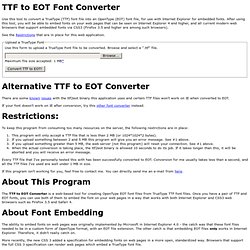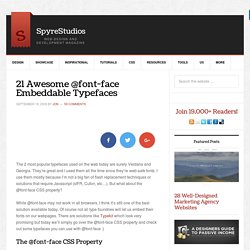

Ttf2eot on the web! Use this tool to convert a TrueType (TTF) font file into an OpenType (EOT) font file, for use with Internet Explorer for embedded fonts.

After using this tool, you will be able to embed fonts on your web pages that can be seen on Internet Explorer 4 and higher, and all current modern web browsers that support embedded fonts via CSS3 (Firefox 3.5 and higher are among such browsers). See the Restrictions that are in place for this web application. There are some known issues with the ttf2eot binary this application uses and certain TTF files won't work on IE when converted to EOT.
If your font doesn't work on IE after conversion, try this other font converter instead. To keep this program from consuming too many resources on the server, the following restrictions are in place: This program will only accept a TTF file that is less than 2 MB (or 1024*1024*2 bytes). If this program isn't working for you, feel free to contact me. Upload a valid TrueType Font file and click the button. @font-face in IE: Making Web Fonts Work. All Hallows’ Eve seems the perfect time for something a little spooky.

Getting @font-face working in IE may just be spooky enough. As you probably know @font-face already works in Safari 3 via WebKit and is supported in the latest Firefox 3.1 beta. With IE, that means around 75% of the world audience could see custom typefaces today if their EULAs allowed it. Fortunately, there are good free faces available to us already, as well as some commercial faces that permit embedding. Fontin is one of them and I’ve built it into this example page: Before we get into the nitty-gritty of making this work, which you can skip to if you wish, I thought a little history and a brief summary of the current status of the web fonts debate might be useful.
Web Fonts: Then & Now. How To Use @font-face In CSS And 21 Great Typefaces. The 2 most popular typefaces used on the web today are surely Verdana and Georgia.

They’re great and I used them all the time since they’re web-safe fonts. I use them mostly because I’m not a big fan of flash replacement techniques or solutions that require Javascript (sIFR, Cufon, etc…). But what about the @font-face CSS property? While @font-face may not work in all browsers, I think it’s still one of the best solution available today. Of course not all type foundries will let us embed their fonts on our webpages. The @font-face CSS Property Before you can start using those typefaces on your site you need to declare the font file(s) in your CSS file along with the font-weight and font-style if available.
Then you can call the font via the font-familly property. Also be sure to check out the ‘further resources‘ section at the bottom of this post for more infos, especially on how to get @font-face to work in IE using EOT font files. CSS property: -webkit-text-size-adjust.